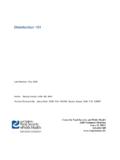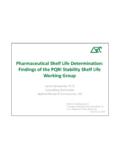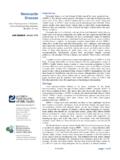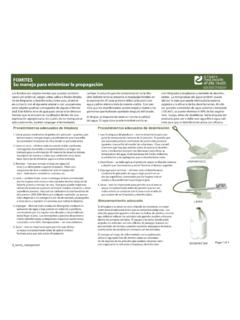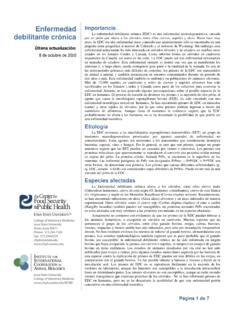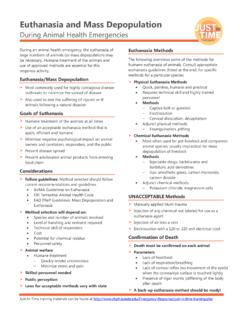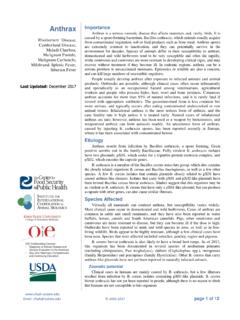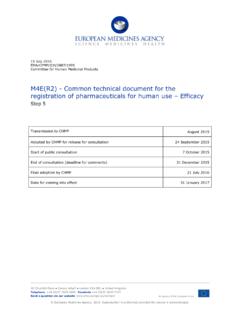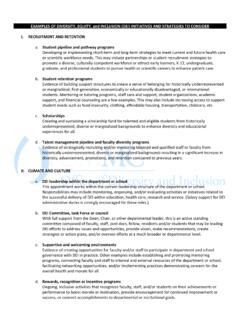Transcription of Disinfection 101 2008 05 - Iowa State University
1 Disinfection 101. Last Modified: May 2008. Author: Glenda Dvorak, DVM, MS, MPH. Portions Reviewed By: James Roth, DVM, PhD, DACVM; Sandra Amass, DVM, PhD, DABVP. Center for food Security and Public Health 2160 Veterinary Medicine Ames, IA 50011. 515-294-7189. Disinfection 101. TABLE OF CONTENTS. 3. Disinfectants 3. Disinfectant Labels .. 4. Label Claims .. 4. Other Important Information on a Product Label.. 5. Considerations and assessment for a Disinfection action plan .. 5. Microorganism 5. Disinfectant 6. Environmental considerations.
2 7. Physical Disinfection .. 9. Classification of Chemical Disinfectants (listed alphabetically) .. 9. Acids .. 9. 10. 10. Alkalis .. 11. 11. Halogens .. 11. Oxidizing Agents .. 12. Phenols .. 13. Quaternary Ammonium 13. Implementing a Disinfection Action Plan .. 13. Assessment .. 14. Cleaning .. 14. Washing/sanitizing .. 14. 15. Evaluation .. 15. Special considerations .. 16. Boot baths .. 16. 17. Foot and Mouth Disease (FMD).. 17. 18. References .. 19. Appendix 1: The Antimicrobial Spectrum of Disinfectants 21.
3 Appendix 2: Characteristics of Selected Disinfectants Table .. 22. 2. Disinfection 101. Introduction Pathogenic organisms can be introduced into a veterinary clinic or animal housing facility through a variety of ways. For this reason, biological risk management (BRM) protocols are necessary to prevent, contain and eliminate the spread of disease. Disinfection protocols, when implemented correctly, can be a cost-effective means of reducing pathogenic organisms and are an important step in any biological risk management program.
4 Prevention of disease is typically easier and more cost-effective than addressing an outbreak situation. Therefore, development and implementation of a step-by-step Disinfection protocol for the control and prevention of infectious disease has become essential for farms and clinics. Disinfection protocols may vary depending on the need of the farm or clinic. No single disinfectant is adequate for all situations. Disinfection protocols used on a daily basis will differ from those needed to control an infectious disease outbreak.
5 However, both have one component in common; thorough cleaning and washing prior to the application of any disinfectant is essential. The purpose of this handout is to provide 1) an overview of factors to consider when developing and implementing an effective Disinfection protocol, 2) an overview of chemicals used for Disinfection , their advantages and limitations, and 3) essential steps of an effective Disinfection protocol. Following development of a Disinfection plan, it is equally important to train personnel of the proper procedures to use and safety issues involved as well as to have the steps posted in prominent locations throughout the facility to serve as a reminder of proper disinfecting techniques.
6 Disinfectants Defined Disinfecting agents are registered by the Environmental Protection Agency (EPA) as antimicrobial pesticides and are substances used to control, prevent, or destroy harmful microorganisms ( , bacteria, viruses, or fungi) on inanimate objects and surfaces. These antimicrobial products have traditionally included sanitizers, disinfectants, and sterilants. Data on a product's chemistry, efficacy, toxicity to humans, animals and plants, and other parameters must be tested and submitted to the EPA prior to the marketing of the Chemical disinfectants can have various effects against microorganisms.
7 Therefore, a basic understanding of the different chemical agents is important. Biocide or germicide refers to chemical agents that kill microorganisms. These general terms includes disinfectants, antiseptics and antibiotics. Germicides and biocides generally react with proteins, specifically essential enzymes of microorganisms. Actions may include oxidation, hydrolysis, denaturation or When a killing action is implied, the suffix cide ( biocide, bactericide, virucide, sporicide) is used, while static ( bacteriostatic, virostatic, sporostatic) is added when an organism's growth is merely inhibited or it is prevented from Sanitizers do not destroy or eliminate all bacteria or microorganisms, but reduce the number of microbial contamination on inanimate surfaces to levels that are considered safe from a public health standpoint.
8 Many sanitizers are a formulation of a detergent and disinfectant. 3. Disinfection 101. Disinfectant describes a product applied directly to an inanimate object. It destroys or irreversibly inactivates most pathogenic microorganisms, some viruses, but not usually ,4,5,6 In comparison, antiseptics are applied to the surface of living organisms or tissues to prevent or stop the growth of microorganisms by inhibiting the organism or by destroying Sterilization refers to the process, either physical ( , extreme heat) or chemical ( ethylene oxide), that destroys or eliminates all forms of life, especially ,4,6.
9 Detergents serve to disperse and remove soil and organic material from surfaces allowing a disinfectant to reach and destroy microbes within or beneath the These products also reduce surface tension and increase the penetrating ability of water, thereby allowing more organic matter to be removed from surfaces. 2 Some disinfectants have detergent properties ( , chlorine compounds, iodophors, QACs). Detergents are classified in three categories: cationic, anionic and non-ionic. Cationic detergents are positively charged solutions, and with the exception or quaternary ammonium compounds (QACs), are seldom used a cleaning ingredients.
10 Anionic detergents, or soaps, are negatively charged alkaline salts of fatty acids. They are less ideal for cleaning because they can be excessively foamy, creating a residue that may allow soil and microorganisms to accumulate. Nonionic (uncharged) detergents are very good emulsifiers, have good penetration and dispersion, are effective at lowering surface tension, and have reduced foaming properties. These products do not typically complex with metallic ions, such as those found in hard water. Most commercial detergents are a combination of anionic and non-ionic.
